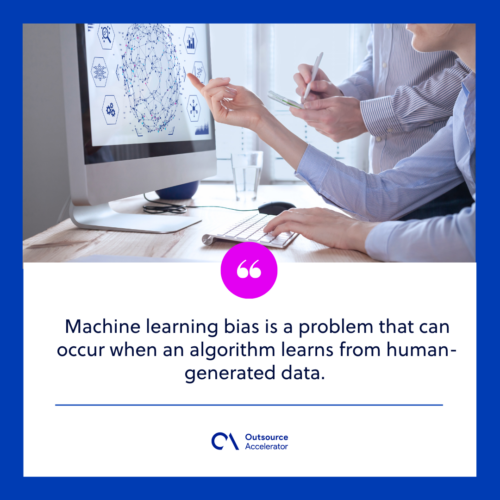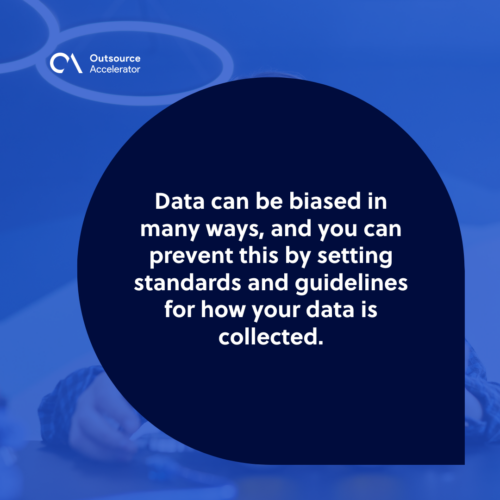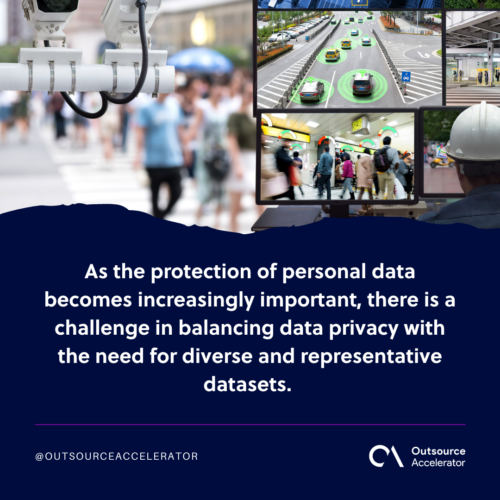Understanding and addressing machine learning bias

In machine learning, algorithms have the power to analyze vast amounts of data and make decisions with remarkable accuracy. However, a critical concern looms large in this realm of artificial intelligence: machine learning bias.
While these algorithms can perform incredible feats, they are not immune to biases that can influence their outcomes and perpetuate societal inequalities.
This article examines the complex issue of machine learning bias, exploring its impact, causes, and, most importantly, best practices to prevent and mitigate bias in machine learning systems.
What is machine learning bias?
Machine learning bias refers to the fact that algorithms are not objective. Since they learn from data, they can inherit the prejudices of their developers and users.
Machine learning bias is a problem that can occur when an algorithm learns from human-generated data. The data set used to train an algorithm may contain human biases that are then passed on to the algorithm.
For instance, an algorithm may discover from past job applications that a woman’s gender on her resume makes her less likely to be hired than a man.
Machine learning bias can lead to unfair treatment of certain groups of people or even discrimination.

Types of machine learning bias
There are multiple ways that a machine learning system can exhibit bias. Some of the most prevalent ones include:
Algorithm bias
Algorithms also suffer from “garbage in, garbage out” problems: If you feed them biased data, they’ll produce biased results.
Algorithm bias refers to algorithms’ inherent limitations and inability to capture all aspects of a problem.
For example, suppose you train an algorithm to classify images into different categories using only photos from one country. In that case, you will end up with an algorithm that performs poorly on pictures from other countries as it doesn’t understand their cultural differences.
This kind of bias isn’t always intentional. It can happen because the people building the system don’t consider how certain data types may affect their model results.
Sampling bias
Sampling bias is a machine learning bias in which a sample is selected so that some members of the population are less likely to be represented than others.
It can also refer to situations with non-random differences among the groups being studied. For example, in medical trials, participants are more likely to receive treatment if they live near a hospital.
This can occur when the selection process involves a non-random mechanism, such as when people with certain characteristics are more likely to respond to a survey. It can also occur when there are differences between those who do not participate in the study and those who do.
Confirmation bias
This form of machine learning bias occurs when a model is trained on a dataset that has been given biased input data and then uses the same data to make predictions about future events.
As a result, the machine spouts information that already supports the user’s beliefs instead of offering anything new like other viewpoints.
This is a concern in machine learning bias because it can cause algorithms to learn from biased data sets, form incorrect hypotheses, and make poor predictions.
Measurement bias
Measurement bias is a type of bias that comes from using a flawed measurement instrument. It can result in incorrect estimates, bad decisions, and even completely inaccurate conclusions.
For machine learning bias, measurement biases are common because the data used to train models often aren’t accurate enough to make good predictions.
Inaccurate data collection can lead to a variety of problems, including:
- Overfitting the model – If you use too much historical data, your model may learn all kinds of patterns related to the past but not necessarily applicable to the future. The model will fail when presented with new data, which it hasn’t seen before.
- Underfitting the model – If you don’t have enough historical data, your model won’t be able to account for all relevant factors contributing to your target variable (e.g., profit).
Exclusion bias
Exclusion bias is a machine learning bias that occurs when an algorithm classifies a data point as irrelevant or unimportant, even though the data point is relevant. The result of exclusion bias is that the algorithm will be less accurate than it could have been.
Exclusion bias can occur in two ways:
- An algorithm excludes some data points because they don’t meet certain criteria.
- An algorithm excludes some groups of people from seeing or using its services based on their characteristics, such as race, gender, and age.
Recall bias
Recall bias is a common type of machine learning bias. It occurs when the results of a model are skewed because the model can only access certain data.
In other words, recall bias means that a model cannot remember enough information about an instance to make an accurate prediction.
Prejudicial bias
Prejudicial machine learning bias refers to the influence of human prejudice on the outcome of an algorithm’s decisions. Prejudicial biases can be conscious or unconscious, resulting from the programmer’s beliefs or simply reflecting society’s values and norms.
This occurs when algorithms are trained to make decisions based on human data that may contain racial, gender, or other types of prejudice.
How to prevent machine learning bias
It’s never too late to regulate machine learning, even with the limited applications of AI that we currently have.
Below are some practices to establish a foundation for preventing machine learning bias:
Set standards and guidelines
A machine learning algorithm only works as well as the data used to train it. Data can be biased in many ways, and you can prevent this by setting standards and guidelines for how your data is collected.
The first step to preventing machine learning bias is to create a code of conduct (or ethics) for your organization. This should include policies on how employees should behave when collecting data.
Next is to create an ethical review board to oversee all machine learning projects in your organization. The board would consist of people from different departments, including HR, sales, marketing, and engineering.

Recognize potential sources of bias
Here are some ways you can recognize potential sources of machine learning bias:
- Understand how your data is collected and processed.
- Look for patterns in your training data.
- Use a diverse set of samples in your training data.
- Test your model against different sets of data.
The most important source is the data itself. If you train your model on biased data, then it’s going to be biased.
Another source of machine learning bias is the model. When you train a model, you’re implicitly making assumptions about how the world works, and those assumptions may lead to bias.
Evaluate models for early indicators
Before deploying these systems into production, organizations should evaluate them for any potential machine learning bias that may be present.
For example, you might want to check whether your model will classify your customer base correctly by using test data that mirrors your customer base as closely as possible.
If there’s any discrepancy between the test data and the real thing, you must investigate further before deploying the system into production.
Monitor and review applications regularly
Machine learning and artificial intelligence on this scale are still relatively new in the business scene. Monitoring them should be a regular priority for organizations.
If the AI isn’t working as expected, you need to find out why before it becomes a problem for your customers or employees. Doing so regularly lets you identify problems before they become big issues.
Future directions and challenges for machine learning bias
Future directions and challenges for machine learning bias include:
Fairness-aware machine learning
There is a growing need for developing fairness-aware machine learning techniques that can explicitly address and mitigate machine learning bias.
Researchers are exploring new approaches, such as causal reasoning, counterfactual fairness, and adversarial debiasing, to enhance the fairness of machine learning models.
Algorithmic transparency and explainability
Enhancing the transparency and interpretability of algorithms is crucial for understanding and addressing machine learning bias.
Efforts are being made to develop methods that provide explanations for the decisions made by AI systems, allowing stakeholders to identify and rectify potential biases.
Intersectionality and multiple biases
Recognizing and addressing the intersectionality of biases is a challenge for machine learning. Multiple machine learning biases can interact and compound each other, leading to complex and nuanced forms of discrimination.
Future research should focus on developing techniques that account for intersectionality and consider the cumulative impact of multiple biases.
Data privacy and bias
As the protection of personal data becomes increasingly important, there is a challenge in balancing data privacy with the need for diverse and representative datasets.
Striking the right balance between privacy concerns and collecting data that accurately represent different demographics remains a challenge in mitigating machine learning bias.

Ethical considerations and regulation
There is a growing recognition of the ethical implications of machine learning bias, prompting the need for ethical frameworks and guidelines.
Policymakers and regulatory bodies are working to establish regulations and standards to ensure fairness, transparency, and accountability in machine learning systems.
Bias in reinforcement learning
Reinforcement learning algorithms that learn through trial and error can also be susceptible to bias.
Addressing biases in these algorithms is an emerging area of research. There should be a focus on developing methods that ensure fair and unbiased outcomes in reinforcement learning scenarios.
Education and awareness
Increasing awareness about machine learning bias and its implications are crucial. Educational initiatives, training programs, and public discourse can equip individuals with the knowledge and skills to recognize and challenge biases in AI systems.
Addressing these future directions and challenges requires collaboration among researchers, industry professionals, policymakers, and the wider public.
By working together, we can pave the way for fair, unbiased, and ethically responsible machine learning systems that truly serve the needs of diverse populations.







 Independent
Independent




